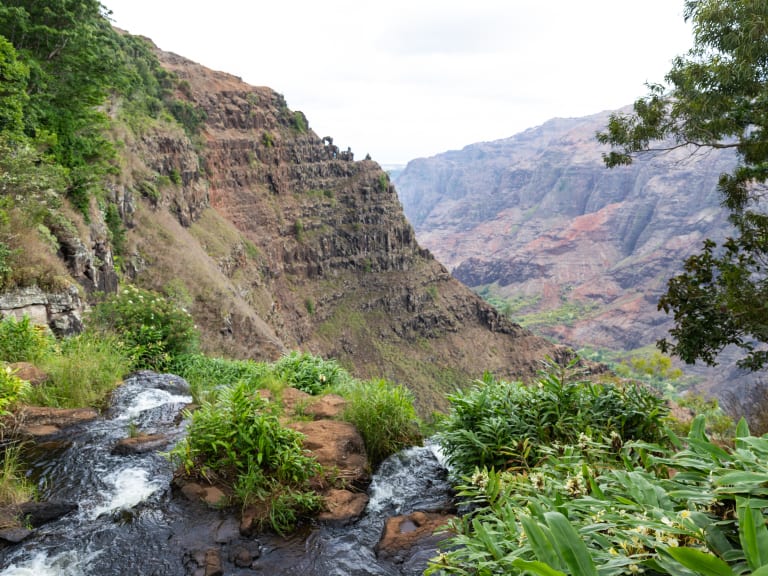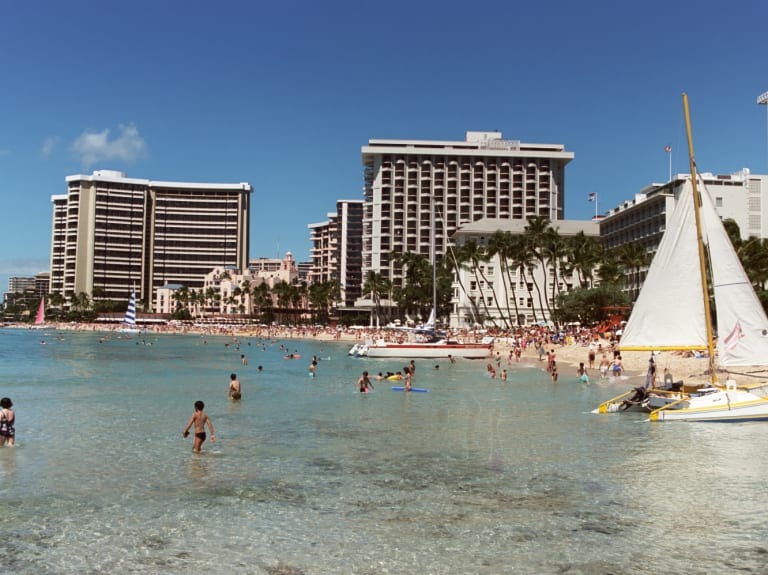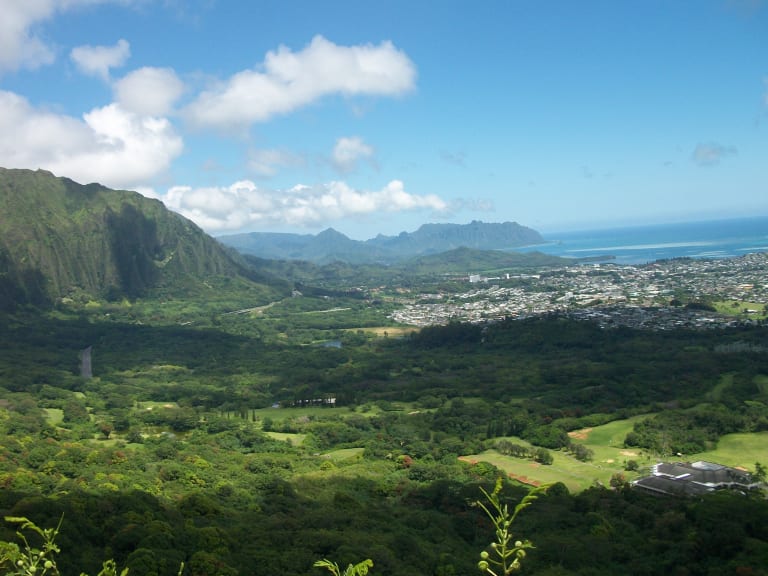More about: 10 Things to Do in Oahu in January
Oahu, the island that hosts Honolulu, the Hawaiian capital, is also the most visited island of this paradisiacal archipelago. If you plan a visit in the first days of the year, you will have cool weather, brimming landscapes and many surf professionals around you. That month you will also encounter cloudy days and maybe some unexpected rain...but don't worry! If the storm changes any of your plans, you will find many other things to see and do in Oahu.
To welcome the year, to start the cycle with travel energy or simply because getting to know Oahu is your annual goal... here's what you can see and do on this island in January. Let's get started!
1. Professional surfing? January with high waves and very exciting championships

Surfing is a very old sport that was historically practiced in most of the Pacific islands, such as New Zealand, Tahiti and New Guinea. However, it was only in Hawaii that the sport really took off and to this day it remains the world's most famous surfing destination.
The winter season in Oahu receives hundreds of thousands of tourists year after year, either to get on their boards or to watch those who dare to do it. During these months, the powerful Pacific storms that hit the region produce waves and unpredictable conditions in the north and west of the island that even the most experienced surfers think twice about.
If you are not part of that group of daring people chasing these water monsters, as I told you, you can be a spectator. Two very popular pro surfing events are regularly held on Oahu's North Shore in January: the Pipeline WSL Championship and the Da Hui Backdoor Shootout. I recommend you check in advance on their websites for dates and schedules.
2. Parade of the life and legacy of Martin Luther King Jr

Martin Luther King Jr. is one of the most important figures in contemporary U.S. history and, in Hawaii, he was always welcomed with a lei.
Here in Hawaii, as in many other places in the United States, the third Monday of January is a day of remembrance and legacy dedicated to this great figure. It is a date to reflect on the efforts for equality and social change, justice and peace, poverty eradication and other social principles that this activist led until his tragic death.
A parade is held with the participation of various activist groups, government, businesses...among others. The parade circuit starts at Magic Island and then turns towards Kalakaua Avenue to finally reach Kapiolani Park. In the park, there are events, music, dancing and lots of food to share with the family.
As a tourist, you should keep in mind that since it is a holiday, it is likely that you will find a museum or other attraction with its doors closed.
Practical Info
- Where: The party is held at Kapiolani Park. 3840 Paki Ave, Honolulu, HI 96815
- Price: free
- When: Third Monday in January
3. Celebrate Chinese New Year

As you probably already know, the Chinese calendar has a different starting date than our Gregorian calendar. The main reason is that it is a lunar calendar, while the Gregorian calendar is a solar calendar.
Chinese culture has a particular taste for calculations, don't you think? So they have managed to make their dates "fit" into our calendar. To offer details on how they arrive at this date I don't consider it relevant in this post, but what I can tell you is that the Chinese New Year can fall between January 21 and February 18.
If you have your trip to Oahu in the first month of the year and you want to know if you will live this celebration on the island, I recommend you to see a calculator like this one, available on the web.
What to expect from the festival? During the most important celebration of the year in the Chinese calendar, the "feed the lion" dances are never lacking. As these colorful and cute creatures dance to the rhythm of live music foraging for food and playing with attendees, they are said to spread good luck and fortune.
The scene is also decorated with lots of red and gold (prosperity, fortune, good luck and joy), the occasional firecracker, characters demonstrating Kung-fu, crafts and gastronomy of the Asian country.
Some places where you can see Chinese New Year events and parties in Oahu are the Chinese Chamber of Commerce of Hawaii, the Ala Moana Center and the Hawaiian Children's Discovery Center.
4. Ohana New Year Festival

Hawaii has a significant multicultural richness and, just as the Chinese do, the Japanese community also celebrates its New Year.
The festival is organized in January at the Japanese Cultural Center of Hawaii, located in Honolulu. It opens its doors to locals and visitors to learn more about the culture of the "Land of the Rising Sun" with exhibitions of dance, traditional dishes, music and martial arts.
Also, there are demonstrations of clothing, bonsai art and bunka shishu embroidery. Origami and fine enamel work are other curiosities to be found here.
The festival is for all ages, including workshops and games for the little ones. More information about the dates and program can be found on the festival's official website.
Practical information
- Where: The festival venue is the Japanese Cultural Center. 2454 S Beretania St, Honolulu, HI 96826
- Price: free
- When: usually on a Sunday in January. See festival website for details
5. Humpback whale season: a natural spectacle not to be missed

Humpback whales have an incalculable significance for the Hawaiian culture. They are present in many of their legends and have also been found depicted on petroglyphs at various sites throughout the islands.
Hawaiians have great respect for these majestic creatures, which they see as "guardians of the family". Each winter, after a long journey from the cold waters of Alaska, these giants arrive in Hawaiian territory to breed and welcome new members into the herds.
These animals can be sighted from practically any point along the extensive Hawaiian coasts, although on Oahu, the place where this possibility increases is the Makapuu lighthouse, or at the different viewpoints near Leahi on the southern end of the island.
In January, the probability of seeing these cetaceans is high, although perhaps there are few calves yet. There are several whale watching tours on the island, some include stops to snorkel with sea turtles and colorful fish.
6. A tour to see volcanoes and... snow!

Hawaii is an archipelago of volcanic nature, that is to say, the islands emerged from the sea millions of years ago by the effect of submarine volcanoes and, this is precisely what gives the islands those exuberant and fertile landscapes, with varied ecosystems and great biological richness.
There are currently three active volcanoes registered : Loihi, which is underwater and far from the south coast of the island of Hawaii, Mauna Loa and Kilauea. The latter two are located in the Hawaii Volcanoes National Park, declared World Heritage Site.
Now that you know they are active(especially Kilauea), you can imagine why more than one million visitors come to the island of Hawaii or "Big Island" every year.
The landscape is like from another planet or another era, the vast lava fields glowing nearby and the large fumaroles are reminiscent of a prehistoric landscape. The terrain is incredibly varied, with areas of arid desert and rainforest, to alpine tundra. Yes! You read that right, here in the winter and particularly in January, there can be snow on the highest parts of the mountains.
A trek through this national park is a unique experience that you should definitely schedule for your trip. Keep in mind that January is among the rainiest months of the year in the archipelago and rain is likely to be present. So be prepared for a day with lots of mud on your shoes and some unexpected downpours. It will be well worth it, I assure you!
7. Excursion to Waimea waterfall in the best scenery season

January is one of the wettest months of the year in Hawaii. It is true that the rain can lead you to change some plans, but also, you should know that the tours with the best views and the experience of observing nature in all its splendor, can be done in the rainy months.
Of course, the possibility of going on tours during the rainy season depends a lot on the safety and enjoyment conditions that each attraction can offer you.
The Waimea waterfall is one of the diverse scenarios that can be visited on the North Shore of Oahu. With an undemanding route, surrounded by landscapes of countless shades of green and a refreshing waterfall (which, by the way, you can swim in the pool), an excursion to this waterfall is an excellent option to spend a day in nature.
There are tours to the Waimea waterfall area from different points of the island and with different activities each one.
One that I recommend is a ten-hour tour that, in addition to the waterfall, will take you to several points of interest around Oahu. These usually include the famous Diamond Head Crater, Sandy Beach, Sunset Beach and even pineapple plantations and shrimp farms.
No doubt, you are in for a long day, but it will allow you to see some of Oahu's extraordinary sites from north to south.
8. Kualoa ranch in January, a ride that will remind you of Hollywood

Another place to have a great time this season in Oahu is the Kualoa Ranch. This place, with more than 1,600 hectares of surface was part of the locations of a very famous production of the 90's: **Jurassic Park.**Now do you see why I tell you that the landscapes here transport you to prehistoric times?
This huge private property has been working since 1850 with the vision of protecting and enhancing the natural beauty present, with recreational and production activities (agriculture and aquaculture) compatible and respectful with the environment.
There are several tourist activities and circuits offered in the park and the Jurassic Park tours are among the most popular, especially for the little ones.
A very exciting tour is the Raptor Tour, where you can ride through the hills aboard an all-terrain vehicle as if you were running away from a nimble dinosaur.
Doing the tour in this month of mud puddles where you will feel like you are part of a stampede with the huge reptiles will be a lot of fun! Be prepared with extra clothes and enjoy this Jurassic park.
Practical Info
- Where: Circuit is located at Kualoa ranch. 49-560 Kamehameha Hwy, Kaneohe, HI. 96744
- Price: from 127 euros
- When: in January (but open all year round)
9. Visit the Honolulu Museum of Art

With so many nature trails and lots of mud and wet clothes, maybe it's time to suggest a quieter, more cultural option that will...at least keep you dry if it starts to rain during your January trip: visit a museum.
One highly recommended option is the Honolulu Museum of Art. The space, with more than 50,000 art objects, is one of the largest collections of Asian and Pacific art in the United States. As if that were not enough, it includes additional exhibits with collections by Van Gogh, Gauguin, Warhol and Hokusai, among others.
The museum's collections are for all ages, so you can bring the little ones along. Keep in mind that touring it in its entirety can take between two and three hours. It is located in a beautiful building in Honolulu, with gardens, cafes and a small theater.
Practical info
- Where: Honolulu Museum of Art. 900 South Beretania Street. Honolulu, HI. 96814
- Price: Average price 20 euros (adults). 0-18 years: free.
- When: the third Monday of the month of January
10. Discover Hawaiian marine biodiversity at the Waikiki Aquarium

Like the above, another especially convenient and "indoor" activity on a rainy January day is to visit the Waikiki Aquarium, located just a few minutes' walk from Waikiki Beach.
More than 3,000 species coexist in these living settings, including colorful fish, corals, elegant jellyfish, turtles, sharks and even huge clams with iridescent hues. You'll be amazed at the extraordinary richness of this region of the world!
The aquarium also offers various activities and classes for visitors to interact more closely with nature and learn more about the conservation of these ecosystems.
If you want to know more details about their exhibits, you will find them in the following link.
Practical info
- Where: Waikiki Aquarium. 2777 Kalākaua Ave, Honolulu, HI. 96815
- Price: average price €12 (adults), €5 (ages 4-12) and free (3 and under).
- When: January (though open year-round).
Weather in Oahu in January

In this part of the world, winter means rainy season. Although not the heaviest, in January rainfall is recurrent and can change your outdoor plans.
January has the lowest temperatures (average 23°C and minimum 19°C), which for a visitor is usually very tolerable. However, if you visit the highlands (hiking the volcanoes or other mountains) you should be aware that this temperature can drop abruptly.
The average water temperature in January is 24.5°C, with very little variation throughout the year (24°C in March to 27°C in September).




